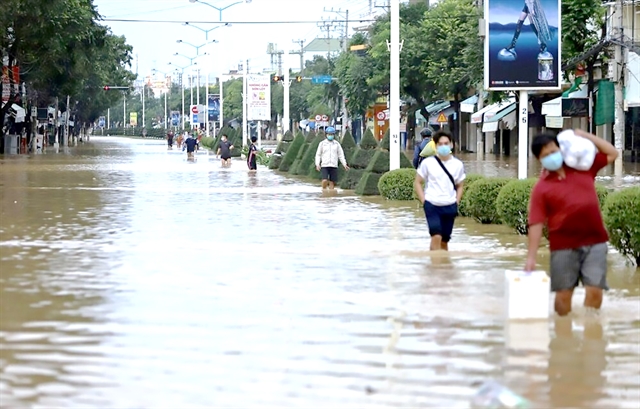 Society
Society

 |
Can Tho city, Ca Mau and Kien Giang provinces are three places heavily affected by climate change. VNA/VNS Photo |
HÀ NỘI – The Mekong Delta region, an area sensitive to environmental changes, faces great challenges from climate change, requiring regional localities to come up with an effective strategy to adapt to extreme weather conditions, reduce emissions and increase recovery capacity, according to experts.
A climate change scenario created in 2016 showed that if the sea level rises by 100 cm, and if no solutions are taken, some 39 per cent of the total area of Mekong Delta will face the risk of flooding. Localities with the highest risk are Hậu Giang (over 80 per cent of the area), Kiên Giang (nearly 77 per cent) and Cà Mau (about 58 per cent).
Alongside, each year, erosion will also cause a loss of about 300 hectares of land and mangrove forest, it said.
Currently, the Mekong Delta region has 564 erosion sites with a total length of over 834km, including 512 sites along river banks with a total length of about 566km, mostly along Tiền, Hậu, Vàm Cỏ Đông and Vàm Cỏ Tây rivers. This includes the main branches of canals, together with 52 sites of coastal erosion areas with a total length of 268km.
Cần Thơ city, Cà Mau and Kiên Giang provinces are three localities hardest hit by climate change from high tide, erosion, heat, storms, and tornadoes, not to mention other negative factors such as saltwater intrusion, environmental pollution and epidemics.
Strategies to adapt
Dr. Muthukumara Mani, an environment expert from the World Bank (WB) in Việt Nam, said Việt Nam in general and the Mekong Delta in particular need to work in two directions to respond to climate change - reducing emissions and increasing the resilience of the economy.
In the first direction, solutions to reduce emissions must be implemented simultaneously in the fields of transport, agriculture and industry through mechanisms of emission pricing and emission taxation, which requires an investment of US$114 million until 2040.
In the second direction, a budget of about US$254 million is needed in the 2022-2040 period to strengthen the recovery capacity of the economy, thus protecting resources, infrastructure and people from climate risks, especially in vulnerable sectors and communities.
According to the master plan of the Mekong Delta in the 2021 - 2030 period with a vision to 2050, the urban system of the region will be built with rational distribution in urban areas, along the main development corridors of the climate-resilient region.
With development orientations in harmony with nature, the Government has issued Resolution No.120 on the sustainable growth of the Mekong Delta region with adaptation to climate change.
The resolution clarified the crucial need to change the development mindset from sole agricultural production focusing on rice to a diversified agricultural economy to meet the needs of the market. Another change in perception that is required is from quantity to quality with the application of high technology, organic agriculture and clean agriculture associated with value chains and brand building, and greater attention on developing processing and supporting industries for agriculture.
Promoting renewable energy
At the 26th UN Climate Change Conference (COP26), Prime Minister Phạm Minh Chính delivered Việt Nam’s strong commitment to net-zero emissions by 2050. Energy transition is an indispensable factor in achieving the goals of sustainable development and climate change adaptation of Viet Nam and the Mekong Delta.
Associate Prof. Dr. Nguyễn Đình Thọ, Director of the Institute of Strategy and Policy on Natural Resources and Environment, said that the Mekong Delta region boasts high potential in developing renewable energy and can become a motivation for Việt Nam to complete the commitments.
With the advantage of a long coastline, the Mekong Delta region has high potential in offshore wind power development, especially in Bạc Liêu, Bến Tre, Sóc Trăng and Trà Vinh provinces.
Deputy Secretary of the Party Committee and Chairman of the People’s Committee of Bạc Liêu Phạm Văn Thiệu said that the province has 56km of coastline and full conditions to become a wind power production hub.
Under a wind power development plan to 2030, Bạc Liêu’s wind power potential could reach 3,500MW. Currently, the province has eight operating wind power projects with total investment of nearly VND23.9 trillion ($1.01 billion) and a combined capacity of 469MW, ranking third in the country. They have contributed VND450 billion to the provincial State budget collection each year, he said.
Meanwhile, in Trà Vinh, the implementation of policies on power development, especially those on renewable power, has been intensified.
Currently, the locality has five wind power plants with a total capacity of 256.8 MW. Recently, Trà Vinh has started construction of a green hydrogen factory on an area of over 20 hectares with a total investment of nearly VND8 trillion. Chairman of the Trà Vinh People's Committee Lê Văn Hà said that the production of green hydrogen from renewable energy will be developed in line with the strategy for the development of Việt Nam's chemical industry to 2030, with a vision to 2040.
In order to create a driving force for production transformation to adapt to climate change in the right direction and with high efficiency, localities in the Mekong Delta have focused on transferring and applying science and technology in the fields of cultivation, breeding and aquaculture. They are also encouraging local enterprises to participate in science and technology research, transfer and application to make breakthroughs in the improvement of productivity and quality of agricultural products as well as their competitiveness. VNS